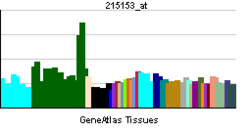- NOS1AP
-
Nitric oxide synthase 1 (neuronal) adaptor protein Identifiers Symbols NOS1AP; 6330408P19Rik; CAPON; MGC138500 External IDs OMIM: 605551 MGI: 1917979 HomoloGene: 40976 GeneCards: NOS1AP Gene Gene Ontology Molecular function • protein binding
• PDZ domain binding
• nitric-oxide synthase bindingCellular component • cytoplasm Biological process • regulation of apoptosis
• regulation of nitric oxide biosynthetic process
• regulation of nitric-oxide synthase activitySources: Amigo / QuickGO RNA expression pattern 
More reference expression data Orthologs Species Human Mouse Entrez 9722 70729 Ensembl ENSG00000198929 ENSMUSG00000038473 UniProt O75052 Q3TRB6 RefSeq (mRNA) NM_001126060.1 XM_129577 RefSeq (protein) NP_001119532.2 XP_129577 Location (UCSC) Chr 1:
162.04 – 162.35 MbChr 1:
172.23 – 172.52 MbPubMed search [1] [2] Nitric oxide synthase 1 adaptor protein (NOS1AP) also known as carboxyl-terminal PDZ ligand of neuronal nitric oxide synthase protein (CAPON) is a protein that in humans is encoded by the NOS1AP gene.[1][2][3]
This gene encodes a cytosolic protein that binds to the signaling molecule, neuronal nitric oxide synthase (nNOS). This protein has a C-terminal PDZ-binding domain that mediates interactions with nNOS and an N-terminal phosphotyrosine binding (PTB) domain that binds to the small monomeric G protein, Dexras1. Studies of the related mouse and rat proteins have shown that this protein functions as an adapter protein linking nNOS to specific targets, such as Dexras1 and the synapsins.[3] NOS1AP polymorphisms has been associated with the QT interval length.[4]
Interactions
NOS1AP has been shown to interact with:
References
- ^ Seki N, Ohira M, Nagase T, Ishikawa K, Miyajima N, Nakajima D, Nomura N, Ohara O (Feb 1998). "Characterization of cDNA clones in size-fractionated cDNA libraries from human brain". DNA Res 4 (5): 345–9. doi:10.1093/dnares/4.5.345. PMID 9455484.
- ^ a b Jaffrey SR, Snowman AM, Eliasson MJ, Cohen NA, Snyder SH (Mar 1998). "CAPON: a protein associated with neuronal nitric oxide synthase that regulates its interactions with PSD95". Neuron 20 (1): 115–24. doi:10.1016/S0896-6273(00)80439-0. PMID 9459447.
- ^ a b "Entrez Gene: NOS1AP nitric oxide synthase 1 (neuronal) adaptor protein". http://www.ncbi.nlm.nih.gov/sites/entrez?Db=gene&Cmd=ShowDetailView&TermToSearch=9722.
- ^ Arking DE, Pfeufer A, Post W, et al. (2006). "A common genetic variant in the NOS1 regulator NOS1AP modulates cardiac repolarization". Nat. Genet. 38 (6): 644–51. doi:10.1038/ng1790. PMID 16648850.
- ^ a b Gotthardt M, Trommsdorff M, Nevitt MF, Shelton J, Richardson JA, Stockinger W, Nimpf J, Herz J (August 2000). "Interactions of the low density lipoprotein receptor gene family with cytosolic adaptor and scaffold proteins suggest diverse biological functions in cellular communication and signal transduction". J. Biol. Chem. 275 (33): 25616–24. doi:10.1074/jbc.M000955200. PMID 10827173.
- ^ Fang M, Jaffrey SR, Sawa A, Ye K, Luo X, Snyder SH (October 2000). "Dexras1: a G protein specifically coupled to neuronal nitric oxide synthase via CAPON". Neuron 28 (1): 183–93. doi:10.1016/S0896-6273(00)00095-7. PMID 11086993.
- ^ Jaffrey SR, Benfenati F, Snowman AM, Czernik AJ, Snyder SH (March 2002). "Neuronal nitric-oxide synthase localization mediated by a ternary complex with synapsin and CAPON". Proc. Natl. Acad. Sci. U.S.A. 99 (5): 3199–204. doi:10.1073/pnas.261705799. PMC 122496. PMID 11867766. http://www.pubmedcentral.nih.gov/articlerender.fcgi?tool=pmcentrez&artid=122496.
Further reading
- Gotthardt M, Trommsdorff M, Nevitt MF, et al. (2000). "Interactions of the low density lipoprotein receptor gene family with cytosolic adaptor and scaffold proteins suggest diverse biological functions in cellular communication and signal transduction". J. Biol. Chem. 275 (33): 25616–24. doi:10.1074/jbc.M000955200. PMID 10827173.
- Hartley JL, Temple GF, Brasch MA (2001). "DNA Cloning Using In Vitro Site-Specific Recombination". Genome Res. 10 (11): 1788–95. doi:10.1101/gr.143000. PMC 310948. PMID 11076863. http://www.pubmedcentral.nih.gov/articlerender.fcgi?tool=pmcentrez&artid=310948.
- Strausberg RL, Feingold EA, Grouse LH, et al. (2003). "Generation and initial analysis of more than 15,000 full-length human and mouse cDNA sequences". Proc. Natl. Acad. Sci. U.S.A. 99 (26): 16899–903. doi:10.1073/pnas.242603899. PMC 139241. PMID 12477932. http://www.pubmedcentral.nih.gov/articlerender.fcgi?tool=pmcentrez&artid=139241.
- Gerhard DS, Wagner L, Feingold EA, et al. (2004). "The Status, Quality, and Expansion of the NIH Full-Length cDNA Project: The Mammalian Gene Collection (MGC)". Genome Res. 14 (10B): 2121–7. doi:10.1101/gr.2596504. PMC 528928. PMID 15489334. http://www.pubmedcentral.nih.gov/articlerender.fcgi?tool=pmcentrez&artid=528928.
- Zheng Y, Li H, Qin W, et al. (2005). "Association of the carboxyl-terminal PDZ ligand of neuronal nitric oxide synthase gene with schizophrenia in the Chinese Han population". Biochem. Biophys. Res. Commun. 328 (4): 809–15. doi:10.1016/j.bbrc.2005.01.037. PMID 15707951.
- Xu B, Wratten N, Charych EI, et al. (2006). "Increased Expression in Dorsolateral Prefrontal Cortex of CAPON in Schizophrenia and Bipolar Disorder". PLoS Med. 2 (10): e263. doi:10.1371/journal.pmed.0020263. PMC 1201690. PMID 16146415. http://www.pubmedcentral.nih.gov/articlerender.fcgi?tool=pmcentrez&artid=1201690.
- Puri V, McQuillin A, Thirumalai S, et al. (2006). "Failure to confirm allelic association between markers at the CAPON gene locus and schizophrenia in a British sample". Biol. Psychiatry 59 (2): 195–7. doi:10.1016/j.biopsych.2005.08.015. PMID 16202394.
- Gregory SG, Barlow KF, McLay KE, et al. (2006). "The DNA sequence and biological annotation of human chromosome 1". Nature 441 (7091): 315–21. doi:10.1038/nature04727. PMID 16710414.
- Post W, Shen H, Damcott C, et al. (2007). "Associations between Genetic Variants in the NOS1AP (CAPON) Gene and Cardiac Repolarization in the Old Order Amish". Hum. Hered. 64 (4): 214–9. doi:10.1159/000103630. PMC 2880727. PMID 17565224. http://www.pubmedcentral.nih.gov/articlerender.fcgi?tool=pmcentrez&artid=2880727.
Categories:- Human proteins
- Chromosome 1 gene stubs
- Biology of bipolar disorder
Wikimedia Foundation. 2010.
